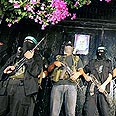
A different future. Hamas. (Illustration)
Photo: Reuters
In the late 1970s, researcher Fouad Ajami wrote an article titled “The End of Pan-Arabism.” At a time when most researchers believed that the movement calling for a political unification of all Arab states was still at its zenith, Ajami argued that a series of processes, headed by the shock of the Six Days War defeat, are a harbinger of pan-Arabism’s demise. He was proven right later on.
Perhaps the time has not yet come to write another article like that, which this time will focus on radical political Islam. However, the Hamas massacre of Fatah members in Gaza brings us another step closer to radical Islam’s political demise.
To this day, many researchers believe that the general population in the Middle East mostly identifies itself with the promoters of radical Islam – The Muslim Brotherhood in Egypt, Iran’s revolutionary regime, and even Osama Bin Laden and the global Jihad movement. Moreover, the vast majority of researchers believe that citizens of Arab countries must experience a phase whereby radical religious regimes replace existing dictatorships in order to ultimately see genuine democratic rule.
However, the combination of three processes paints a different picture: The failure of Iran’s Islamic revolution, the murderous struggle of Sunnis against Shiites in Iraq, and the rise of moderate Islam in Turkey. Last week a fourth process, and possibly a deciding one, wad added to the mix – the exposure of the Gaza Islamic regime’s cruel face.
There is no need to say much about the first three abovementioned processes. Iran’s Islamic regime, whether in its reformist periods or under Ahmadinejad’s neo-conservative model, has failed in creating a new reality for the Iranian people. At best, nothing has changed since the days of the Shah, yet in the eyes of many the situation has become much worse.
The struggle between the Sunnis and Shiites, which started about three years ago, reached an unprecedented nadir, which in the eyes of many symbolizes the bankruptcy of religious clerics in both camps and their inability to bring about reconciliation even within the Islamic camp.
‘Massacre of innocents’
As opposed to these two examples, we see the example of Turkey’s ruling party, a moderate, pro-Western party that objects to the radical violence, combines national values with religious belief, and promotes Islamic moral and family values in the best tradition of conservative parties in Western Europe. The fourth process revealed these days – the true face of Hamas’ rule – tips the scale.It is hard to assess the deep public undercurrents in Arab countries. In the absence of a democratic culture, public opinion polls do not attest to the public’s innermost thoughts and the dictatorial rule finds it convenient to market radical Islam as a menacing enemy that could take over the government should this dictator lose the world’s support.
However, the waves of reactions in the wake of what Hamas has done reveal a hint of these undercurrents. The serious shock reflected in international Arab media outlets and headlines bemoaning the “bloodshed” and “massacre of innocents” are different than the usual descriptions of difficult incidents in our region. There is a genuine sense of outcry.
For many in the Arab world, Hamas symbolized the hope for a different future. Hamas was the first Islamic, Arabic and Sunny organization to take power and promised a better future in line with the spirit of Islam. Until now, it was possible to explain the violence it displayed in the need to fight against dangerous gunmen. The massacre in Gaza, which according to all testimonies was directed at a crowd that at most hurled stones, massacred the hope as well. We shall see the results in the coming decades.
Professor Dror Zeevi is a lecturer at Ben Gurion University’s Middle Eastern Studies Department















